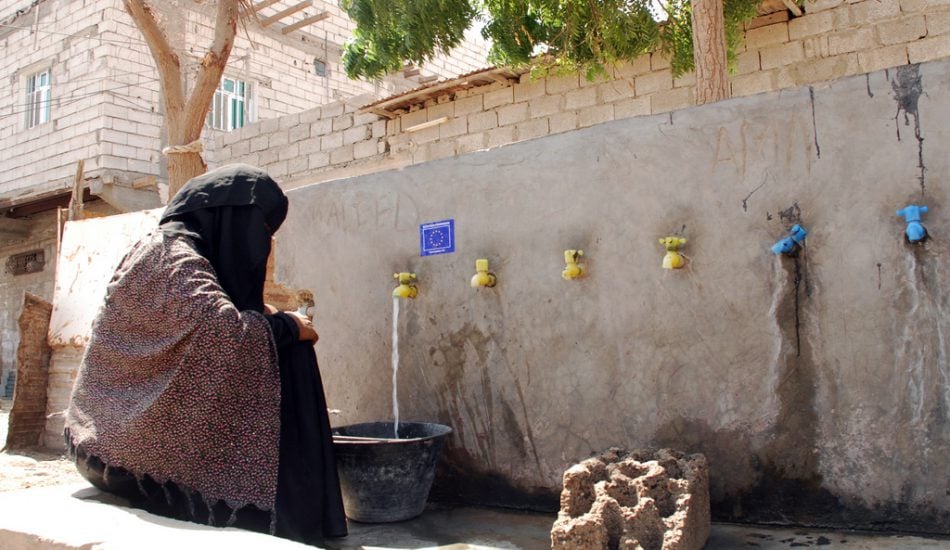
Surface water quality
There are no networks monitoring surface water quality in Yemen, as far as is known. Various projects have measured surface water salinity but only at a few sites. In most cases, measurements of electric conductivity (EC) were obtained during current metering. The EC in some major wadis, such as Wadi Surdud and Adhanah, and in the Abyan Delta show that the EC of water varies between 500-600 deciSiemens per metre (dS/m) during base flow and drops to 300 dS/m or slightly more during floods. The corresponding figures for Wadi Bana are 1,500-1,800 dS/m for periods of low flows and 400-500 dS/m for floods.[1]
Groundwater quality
Groundwater quality has not been studied in great detail in terms of its suitability as irrigation or drinking water. Cities and industries discharge untreated domestic and industrial wastewater in peri-urban areas. While the dangers of urban wastewater pollution are more visible, there is also a potential pollution hazard to aquifers from untreated wastewater from rural settlements. Saline intrusion is also a problem along the coast. A recent study in al-Jar in the north-west, some 8 km from the Red Sea, mentioned that the EC increased from 225 to 3,480 microSiemens per centimetre (µS/cm) (at 25°C) due to seawater intrusion into the aquifer. During the past 20 years, there has been huge investment in the al-Jar area, leading to the cultivation of more than 3,500 ha of mango trees and the drilling of about 2,000 wells.[2]
Environmental and health risks
Yemen is experiencing severe environmental issues in both water and land resources. Regarding water, Yemen has limited natural freshwater resources and inadequate supplies of potable water. Regarding land, overgrazing and desertification are the primary problems. Al-Gheethi et al. evaluated secondary effluents and biosolids generated from four sewage treatment plants.[3] The study revealed that concentrations of faecal coliforms (FCs) were higher than those recommended by the World Health Organization (WHO) guidelines in all wastewater samples. FCs in 50% of the biosolids were more than the standard limits recommended by the United States Environmental Protection Agency Class B. The study detected 88.88% of Escherichia coli, 70.37% of Streptococcus faecalis, 66.67% of Klebsiella pneumonia, 59.23% of Enterobacter aerogenes, 33.33% of Salmonella typhi, 25.93% of S. typhimurium, 25.93% of Shigella sonni and 22.2% of Yersina pestis in the samples.
Research conducted by the Water and Environment Centre on the suitability of sludge from Sanaa’s WWTP for use as a fertilizer revealed that the sludge would need to be dried for at least three months to free it of helminth eggs and FCs. Previous research conducted into sludge from five main WWTPs in the cities of Arman, Hajjah, Ibb, Yarim and Aden showed that the sludge was still polluted with pathogenic bacteria and helminth eggs even after it was dried [4]. The leachate from landfills is considered another threat to the groundwater.[5] Generally, a host of factors associated with water resource development changes the human and biological environment and triggers other consequences. Even when outbreaks of water-related diseases conclusively follow from irrigation development, the importance of this impact is extremely difficult to determine.[6]
[1] Al-Gheethi A et al., 2015. Solar disinfection and lime stabilization processes for reduction of pathogenic bacteria in sewage effluents and biosolids for agricultural purposes in Yemen. Journal of Water Reuse and Desalination 5:419-429.
[2] FAO, 2018. Yemen Plan of Action 2018-2020.
[3] Al-Gheethi A et al., 2014. Effectiveness of selected wastewater treatment plants in Yemen for reduction of faecal indicators and pathogenic bacteria in secondary effluents and sludge. Water Practice and Technology 9(3): 293-306.
[4] Water and Environment Centre, Sana’a university (2003). Analysis of a study reuse of treated effluent and sludge in Aden, Amran, Hajjah, Ibb, and Yarim
[5] Al-Sabahi E and al-Nozaily F, 2012. Ecological study on characterization of leachate at Ibb landfill using physicochemical and biological analysis. Archiwum Gospodarki Odpadami i Ochrony Srodowiska 14(2): 29-42.
[6] Al-Gheethi A et al., 2014. Effectiveness of selected wastewater treatment plants in Yemen for reduction of faecal indicators and pathogenic bacteria in secondary effluents and sludge. Water Practice and Technology 9(3): 293-306.
